‘Chac Mool’ – Intriguing Life-Size Figure Carved In Single Stone
A. Sutherland - AncientPages.com - “Chac Mool” (chacmool) is one of the most famous ancient statues throughout Mexico and it has been seen in many important ancient places.
'Chacmool' literally means "red or great jaguar paw" (chac means "large" or "red" and mool means "jaguar paw" in Yucatec Maya, and refers to a large number of three-dimensional and curious male figures in Precolumbian Mesoamerican art.
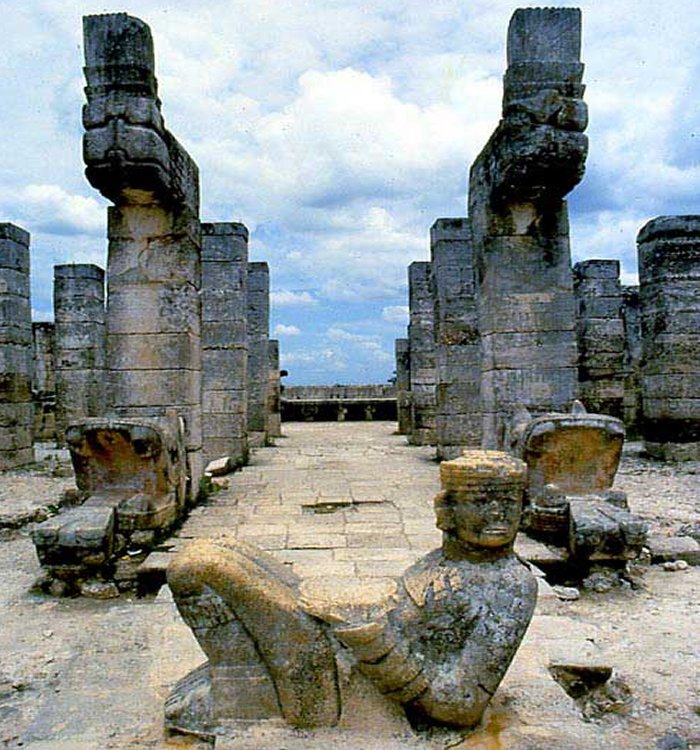
Despite the great number of these figures that are known and recorded, convincing arguments for their origin, dissemination, and meaning have not been proposed. Photo via mexicolore.co.uk
The monumental stone sculpture known as a “Chacmool” first appeared suddenly in Mesoamerica, probably in the 9th century CE.
The most famous statue of this type was excavated in the area of the Platform of the Eagles and Jaguars in Chichen Itza in 1875 by the nineteenth-century explorer Augustus Le Plongeon (1825 – December 13, 1908).

Excavated in 1943 at the corner of Venustiano Carranza and Pino Suarez Streets, Mexico City. Wears a Tlaloc mask and a pendant with an archaistic motif. Photo via latinamericanstudies.org
Le Plongeon named it Chacmol, which he said was Maya for “the paw swift like thunder.” He believed that the statue depicted a warrior prince with that name who once ruled Chichen Itza. However, the first published account of such a statue appeared in 1832.
Altogether, archaeologists have discovered 14 chacmools at Chichen Itza, 12 at Tula, home of the Toltec civilization near present-day Mexico City.
A few other, different forms of chacmools were found in several other such places as Tenochtitlan (Templo Mayor), Quirigua in Guatemala, Tazumal in El Salvador, Michoacan, Tlaxcala near Tula, along with Cempoala, an important Mesoamerican archaeological site located in the state of Veracruz.
The Chaacmol does not appear to be of Maya origin. The ancient name for this type of sculpture is unknown. It is also uncertain what or who the statue represents or what its purpose might have been.
See also:
Pulque: Ancient Drink Of The Gods Is Popular Again But It Has Odd Side-Effects
The figures have rather a unique posture; they support themselves on their elbows with their heads facing 90 degrees from the front. They hold a bowl or a disk or perhaps plate upon their stomachs.
However, these sculptures were often associated with sacrificial stones or thrones.
Despite the great number of these figures that are known and recorded, convincing arguments for their origin, dissemination, and purpose have yet to be made.
Written by – A. Sutherland AncientPages.com Staff Writer
Copyright © AncientPages.com All rights reserved. This material may not be published, broadcast, rewritten or redistributed in whole or part without the express written permission of AncientPages.com
Expand for referencesReferences:
Yale University, Latin America Studies
Academia
More From Ancient Pages
-
 Nomadic Pasture Farming Was Developed 7,000 Years Ago In Swiss Alps
Archaeology | Apr 13, 2017
Nomadic Pasture Farming Was Developed 7,000 Years Ago In Swiss Alps
Archaeology | Apr 13, 2017 -
 Three 17th Century Shipwrecks Discovered In Central Gothenburg, Sweden
Archaeology | Oct 8, 2019
Three 17th Century Shipwrecks Discovered In Central Gothenburg, Sweden
Archaeology | Oct 8, 2019 -
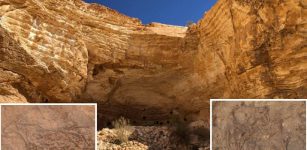 Remarkable Ancient Animal Engravings Discovered In Unknown Cave In Sinai
Archaeology | May 1, 2020
Remarkable Ancient Animal Engravings Discovered In Unknown Cave In Sinai
Archaeology | May 1, 2020 -
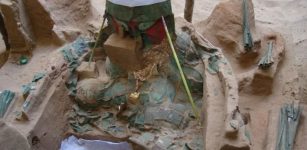 Tomb Of A 1,000-Year-Old Sican Surgeon Wearing A Golden Mask Discovered In Peru
Archaeology | Mar 30, 2022
Tomb Of A 1,000-Year-Old Sican Surgeon Wearing A Golden Mask Discovered In Peru
Archaeology | Mar 30, 2022 -
 Celtiberians: Intriguing Martial Culture And Their Skilled Warrior Infantry
Civilizations | Jul 13, 2024
Celtiberians: Intriguing Martial Culture And Their Skilled Warrior Infantry
Civilizations | Jul 13, 2024 -
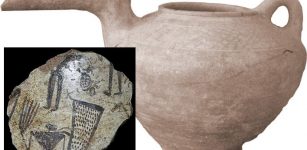 7,000-Year-Old Tepe Ozbaki Mounds Yielded Valuable Relics – But Now The Site Is In Trouble
Archaeology | Nov 25, 2020
7,000-Year-Old Tepe Ozbaki Mounds Yielded Valuable Relics – But Now The Site Is In Trouble
Archaeology | Nov 25, 2020 -
 Freya And Her Lovely Husband Odr, God Of Summer Sun And Passion In Norse Mythology
Featured Stories | Dec 3, 2018
Freya And Her Lovely Husband Odr, God Of Summer Sun And Passion In Norse Mythology
Featured Stories | Dec 3, 2018 -
 Police Forces That Kept Order In Ancient Streets
Ancient History Facts | Jun 12, 2018
Police Forces That Kept Order In Ancient Streets
Ancient History Facts | Jun 12, 2018 -
 Yomi – Kingdom Of The Dead In Japan’s Native Shinto Religion
Featured Stories | Jun 7, 2021
Yomi – Kingdom Of The Dead In Japan’s Native Shinto Religion
Featured Stories | Jun 7, 2021 -
 Moses’ Secret Knowledge Of Superior And Forbidden Technology – Alien Intervention And Events Erased From Historical Records – Part 2
Ancient Mysteries | Sep 24, 2020
Moses’ Secret Knowledge Of Superior And Forbidden Technology – Alien Intervention And Events Erased From Historical Records – Part 2
Ancient Mysteries | Sep 24, 2020 -
 Kunlun Mountain – Mythical Dwelling Place Of Gods, Sacred Animals And Symbol Of Axis Mundi In Chinese Mythology
Chinese Mythology | Jan 31, 2019
Kunlun Mountain – Mythical Dwelling Place Of Gods, Sacred Animals And Symbol Of Axis Mundi In Chinese Mythology
Chinese Mythology | Jan 31, 2019 -
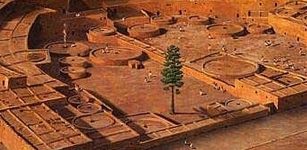 Ponderosa Pine: Life And Death Of One Of America’s Most Mysterious Trees
News | Mar 18, 2020
Ponderosa Pine: Life And Death Of One Of America’s Most Mysterious Trees
News | Mar 18, 2020 -
 Anaximander Of Miletus: Father Of Cosmology, Pre-Socratic Greek Philosopher Who Discovered Equinox, Solstices And Gnomon
Featured Stories | Mar 7, 2019
Anaximander Of Miletus: Father Of Cosmology, Pre-Socratic Greek Philosopher Who Discovered Equinox, Solstices And Gnomon
Featured Stories | Mar 7, 2019 -
 Lacrosse Was Invented By Native American Indians
Ancient History Facts | May 1, 2016
Lacrosse Was Invented By Native American Indians
Ancient History Facts | May 1, 2016 -
 Illuminated Ancient Manuscripts Reflect 1,000 Years Of Human History
Artifacts | Sep 12, 2015
Illuminated Ancient Manuscripts Reflect 1,000 Years Of Human History
Artifacts | Sep 12, 2015 -
 2,500-Year-Old Tibetan Medical Text Describes A Coronavirus-Like Outbreak In Surprisingly Accurate Details
News | Oct 26, 2020
2,500-Year-Old Tibetan Medical Text Describes A Coronavirus-Like Outbreak In Surprisingly Accurate Details
News | Oct 26, 2020 -
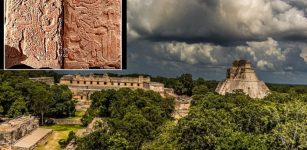 Ancient Maya Stela Carved On Both Sides Unearthed ‘In Situ’ In Uxmal, Yucatan Peninsula
Archaeology | Oct 31, 2022
Ancient Maya Stela Carved On Both Sides Unearthed ‘In Situ’ In Uxmal, Yucatan Peninsula
Archaeology | Oct 31, 2022 -
 Unraveling The Mystery Of Ancient ‘False Doorways’
Ancient Mysteries | May 24, 2014
Unraveling The Mystery Of Ancient ‘False Doorways’
Ancient Mysteries | May 24, 2014 -
 What Happened To Britain’s Economy After The Romans Left?
Archaeology | Sep 11, 2025
What Happened To Britain’s Economy After The Romans Left?
Archaeology | Sep 11, 2025 -
 Mystery Of A 5,000-Year-Old Mass Grave In Poland Reveals A Family Tragedy
Archaeology | May 14, 2019
Mystery Of A 5,000-Year-Old Mass Grave In Poland Reveals A Family Tragedy
Archaeology | May 14, 2019


